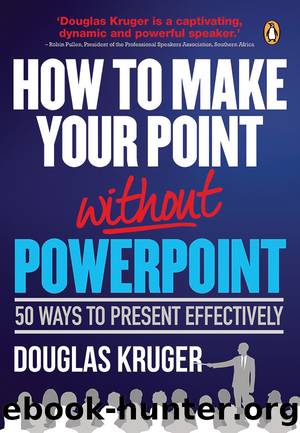How to Make Your Point without Powerpoint: 50 Way to Present Effectively by Douglas Kruger

Author:Douglas Kruger
Language: eng
Format: epub
Tags: The art of presenting needs a serious shake-up.
ISBN: 978-1-77022-924-2
Publisher: Penguin Books
Published: 2016-01-21T16:00:00+00:00
20. Break something
That’s right. Break something. Go Greek! Throw that plate and shout your hearty, ‘Opa!’ Why shouldn’t you?
Why should you? Because people in conferences do not expect to see something broken. Formally dressed, in attendance at an event with certain accepted social norms, they expect to sit in semi-darkness and see reams of mind-numbing PowerPoint slides from the safety of their comfort zones. They expect conference behaviour. So surprise them. The impact can be tremendous.
Your audience members are in a certain social behavioural mode and, for that reason, when you take out a dish or a plank, a vase or a lightbulb, a balloon or a long-playing gramophone that once belonged to your beloved Aunt Martha and break it spectacularly against a pillar, smash it loudly on the ground, pop it theatrically with a pin or pound it vigorously with a hammer (this one’s quite satisfying) – the impact is meteoric.
At the heart of this technique is simple shock value. And that means that we are walking a fine line with this technique. Good taste is on one side and shocking just for the sake of being shocking is on the other.
I believe that the guiding principle for this technique should be this: does it add something to your presentation? Does it help you to communicate your idea and your message? If not, you may just be doing it for your own benefit.
But if it does, boy oh boy, you have one of the world’s greatest attention grabbers in your oratory arsenal!
It makes a particularly good opener. If you choose to go this route, you might even opt to walk on stage in silence and – without greeting the audience – start by breaking your object.
I once used this technique in a contest-winning speech for Toastmasters. The speech was titled Look at Me! and its theme was the exploration of how people validate one another in relationships. I referred to Shall We Dance?, a movie featuring Richard Gere and Susan Sarandon, in which Sarandon’s character explains why humans need relationships. ‘We need a witness to our lives,’ she says, in a touching little speech to a cynical private eye who is asking why she thinks people ever bother to get together in the first place.
To add a little theatricality to my delivery, I opened my speech by walking onto the stage in silence. There (set up in advance) was a small table, with a single champagne glass, standing atop a silk napkin. After a few moments of eye contact with the audience, I turned and picked up the glass, examined it for a second, then wrapped it in the napkin. I then lowered it to the floor, and – acting out a Jewish wedding tradition – stomped on it.
This got an excellent reaction from the audience, whom I then addressed for the first time with my opening line, ‘Why do people marry? Why do we bother to get together?’
The theatrical effect was excellent, although I can tell you that it takes a little courage to start with a bit of theatre carried out in silence.
Download
This site does not store any files on its server. We only index and link to content provided by other sites. Please contact the content providers to delete copyright contents if any and email us, we'll remove relevant links or contents immediately.
| Bookkeeping | Business Mathematics |
| Business Writing | Communications |
| Decision Making | Negotiating |
| Project Management | Running Meetings & Presentations |
| Secretarial Aids & Training | Time Management |
| Training |
Nudge - Improving Decisions about Health, Wealth, and Happiness by Thaler Sunstein(7615)
Deep Work by Cal Newport(6879)
Principles: Life and Work by Ray Dalio(6209)
Factfulness: Ten Reasons We're Wrong About the World – and Why Things Are Better Than You Think by Hans Rosling(4694)
The Doodle Revolution by Sunni Brown(4685)
Eat That Frog! by Brian Tracy(4434)
Thinking in Bets by Annie Duke(4152)
Hyperfocus by Chris Bailey(4046)
Visual Intelligence by Amy E. Herman(3723)
Writing Your Dissertation in Fifteen Minutes a Day by Joan Bolker(3670)
Ogilvy on Advertising by David Ogilvy(3508)
How to Win Friends and Influence People in the Digital Age by Dale Carnegie & Associates(3495)
Hidden Persuasion: 33 psychological influence techniques in advertising by Marc Andrews & Matthijs van Leeuwen & Rick van Baaren(3472)
How to win friends and influence people by Dale Carnegie(3397)
The Pixar Touch by David A. Price(3362)
Schaum's Quick Guide to Writing Great Short Stories by Margaret Lucke(3319)
Deep Work: Rules for Focused Success in a Distracted World by Cal Newport(3146)
Work Clean by Dan Charnas(3048)
The Slow Fix: Solve Problems, Work Smarter, and Live Better In a World Addicted to Speed by Carl Honore(2947)
